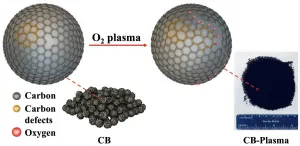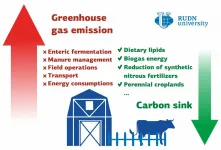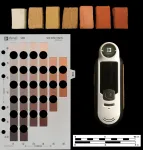(Press-News.org) An electrocardiogram (ECG) is an examination that records the electrical activity of the heart during the cardiac cycle. It is non-invasive and usually involves placing electrodes on the subject's skin. It is a most indicated type of examination when there is suspected heart disease and also in routine preventive health check-ups.
The cardiac cycle entails the emptying of blood from the atria to the ventricles ("P" wave, red in the image), the contraction of the ventricles to propel blood to the different tissues and organs of the body ("QRS" wave, green in the image), and the relaxation of the ventricles to get ready for the next heartbeat ("T" wave, magenta in the image).
The electrocardiographic signal is, however, underutilized from a technological point of view. "While many cardiologists and specialized health personnel have experience in interpreting an electrocardiogram and attempting diagnosis, much of this process is not automated", explains Guillermo Jiménez-Pérez, first author of a paper published in Scientific Reports which presents an algorithm to delineate an electrocardiogram, that is, an analytical method to perform a separation/quantification of the different phases involved in the cardiac cycles.
The measurements of the different phases of the cardiac cycle must be made robustly, that is, they must be applicable to the broad variability of possible cases. In the first place, due to the many possible morphologies that may arise from patient to patient (the picture depicts a representation of different pathological and normal heartbeats, which may vary greatly between individuals), and also to promote their use for subsequent comparative analyses. "That is, being able to obtain the morphology of the different QRS of a particular patient may help identify which aspects of the QRS are abnormal in relation to the general population - or even with regard to the patient a few years earlier", Pérez-Jiménez explains.
This work was published in Scientific Reports on 13 January, and was conducted by Guillermo Jiménez-Pérez and Oscar Camara, members of the PhySense research group, within the BCN MedTech Research Unit, attached to the UPF Department of Information and Communication Technologies (DTIC), together with Alejandro Alcaide of San Jorge University in Zaragoza.
Imatge inicial
An electrocardiogram (ECG) is an examination that records the electrical activity of the heart during the cardiac cycle. It is non-invasive and usually involves placing electrodes on the subject's skin. It is a most indicated type of examination when there is suspected heart disease and also in routine preventive health check-ups.
The cardiac cycle entails the emptying of blood from the atria to the ventricles ("P" wave, red in the image), the contraction of the ventricles to propel blood to the different tissues and organs of the body ("QRS" wave, green in the image), and the relaxation of the ventricles to get ready for the next heartbeat ("T" wave, magenta in the image).
Delineating an electrocardiogram entails performing separation/quantification of the different phases involved in the cardiac cycles
The electrocardiographic signal is, however, underutilized from a technological point of view. "While many cardiologists and specialized health personnel have experience in interpreting an electrocardiogram and attempting diagnosis, much of this process is not automated", explains Guillermo Jiménez-Pérez, first author of a paper published in Scientific Reports which presents an algorithm to delineate an electrocardiogram, that is, an analytical method to perform a separation/quantification of the different phases involved in the cardiac cycles.
The measurements of the different phases of the cardiac cycle must be made robustly, that is, they must be applicable to the broad variability of possible cases. In the first place, due to the many possible morphologies that may arise from patient to patient (the picture depicts a representation of different pathological and normal heartbeats, which may vary greatly between individuals), and also to promote their use for subsequent comparative analyses. "That is, being able to obtain the morphology of the different QRS of a particular patient may help identify which aspects of the QRS are abnormal in relation to the general population - or even with regard to the patient a few years earlier", Pérez-Jiménez explains.
This work was published in Scientific Reports on 13 January, and was conducted by Guillermo Jiménez-Pérez and Oscar Camara, members of the PhySense research group, within the BCN MedTech Research Unit, attached to the UPF Department of Information and Communication Technologies (DTIC), together with Alejandro Alcaide of San Jorge University in Zaragoza.
An algorithm for automating electrocardiograms
For the study authors, the fact that the electrocardiography technique is not yet automated is surprising, considering that at present, many of the major trends related to technology are based on automation through the development of artificial intelligence algorithms.
It is in this context that the work published in Scientific Reports is framed. By using cutting-edge artificial intelligence techniques, an algorithm has been developed for the delineation of the electrocardiogram, improving performance over other algorithms available in the literature.
This kind of technologies should be used with caution and, especially, looking to the future
These algorithms are obtained by the capturing and processing of massive data and, once developed, they are able to process new data very quickly and robustly. This paradigm, of artificial intelligence, has many positive externalities, such as processing capacity and the use of increasingly larger amounts of data which, in turn, are useful for the annotation and processing of new data, thus creating positive feedback loops that eventually lead to benefits for the user.
"This kind of technologies should be used with caution and, especially, looking to the future", the study authors assert. It is of paramount importance to use artificial intelligence to process data so that the results obtained can be immediately interpreted; i.e., artificial intelligence aimed at obtaining measurements (quantification) of the objective reality that surrounds it.
"These measurements can be used in subsequent processes to perform more complex tasks such as, returning the original issue, simplifying the physician's workload or the accurate diagnosis of heart problems", Jimenez-Perez explains. In short, they are reliable technologies for performing many types of subsequent analyses that can be directly interpreted by health personnel, fulfilling all the requirements of ethics and confidentiality required in the field of biomedicine.
INFORMATION:
ATLANTA--ProAgio, a drug developed by Georgia State University biology professor Zhi-Ren Liu and his team, is effective at treating pancreatic cancer and prolonging survival in mice, according to a study published in the journal Cellular and Molecular Gastroenterology and Hepatology.
A second study, published in the Journal of Experimental Medicine, shows the drug is also effective against triple-negative breast cancer, a fast-growing and hard-to-treat type of breast cancer that carries a poor prognosis.
ProAgio, created from a human protein, targets the cell surface receptor integrin αVβ?, which is expressed on cancer-associated fibroblasts. Fibroblasts are cells ...
HOUSTON - (Feb. 9, 2021) - Rice University researchers have created a "defective" catalyst that simplifies the generation of hydrogen peroxide from oxygen.
Rice scientists treated metal-free carbon black, the inexpensive, powdered product of petroleum production, with oxygen plasma. The process introduces defects and oxygen-containing groups into the structure of the carbon particles, exposing more surface area for interactions.
When used as a catalyst, the defective particles known as CB-Plasma reduce oxygen to hydrogen peroxide with 100% Faradaic efficiency, a measure of charge transfer in electrochemical reactions. The process shows promise to replace the complex anthraquinone-based production ...
With the COVID-19 pandemic entering its second year, the challenges faced both by individuals and nations remain substantial. While notable medical advancements in the treatment of COVID-19 have been made, a host of questions about how to live with it and how to work to end it remain active.
Carnegie Mellon University researchers David Rode and Paul Fischbeck explore these questions in a new article, "On ambiguity reduction and the role of decision analysis during the pandemic," published in a special issue of the journal END ...
Wintertime outbreaks of COVID-19 have been largely driven by whether people adhere to control measures such as mask wearing and social distancing, according to a study published Feb. 8 in Nature Communications by Princeton University researchers. Climate and population immunity are playing smaller roles during the current pandemic phase of the virus, the researchers found.
The researchers -- working in summer 2020 -- ran simulations of a wintertime coronavirus outbreak in New York City to identify key factors that would allow the virus to proliferate. They found that relaxing control measures in the summer months led to an outbreak in the winter regardless of climate factors.
"Our results implied that lax control measures -- and likely ...
Ancient Amazonian communities fortified valuable land they had spent years making fertile to protect it from conflict, excavations show.
Farmers in Bolivia constructed wooden defences around previously nutrient-poor tropical soils they had enriched over generations to keep them safe during times of social unrest.
These long-term soil management strategies allowed Amazonians to grow nutrient demanding crops, such as maize and manioc and fruiting trees, and this was key to community subsistence. These Amazonian Dark Earths, or Terra Preta, were created through burning, mulching, and the deposition of organic waste.
It was known that some communities built ditches ...
An ecologist from RUDN University suggested a method to evaluate and reduce the effect of animal farms on climate change and developed a set of measures for small farms that provides for the complete elimination of greenhouse gas emissions. The results of the study were published in the Journal of Cleaner Production.
Crop and animal farming and other agricultural activities account for almost a quarter of all greenhouse gases produced by humanity and therefore add a lot to climate change. On the other hand, the soils and biomass accumulate a lot of carbon, thus preventing it from getting into the atmosphere as a part of carbon dioxide and slowing climate change down. An ecologist from RUDN University suggested ...
Ithaca, NY--Love them or hate them, there's no doubt the European Starling is a wildly successful bird. A new study from the Cornell Lab of Ornithology examines this non-native species from the inside out. What exactly happened at the genetic level as the starling population exploded from just 80 birds released in New York City's Central Park in 1890, peaking at an estimated 200 million breeding adults spread all across North America? The study appears in the journal Molecular Ecology.
"The amazing thing about the evolutionary changes among starling populations ...
The term "algae" is used to refer to over 72,500 identified aquatic species. The size of algae is up to tens of meters, however, most (about 80%) of the species are much smaller - they comprise the microalgae group. Microalgae are rich in nutrients and biologically active substances such as proteins, carbohydrates, lipids, vitamins, pigments and others. These components are widely used in food, cosmetic, chemical and energy industries. Biotechnology of microalgae has multiple advantages: they are a renewable and sustainable resource, more productive than terrestrial plants due to their high growth rate and lack of seasonality ...
LAWRENCE -- Traditional burial in a graveyard has environmental costs. Graves can take up valuable land, leak embalming chemicals and involve nonbiodegradable materials like concrete, as well as the plastic and steel that make up many caskets. But the other mainstream option -- cremation -- releases dangerous chemicals and greenhouse gasses into the environment.
So, what's an environmentalist to do when making plans for the end of life?
A new study from the University of Kansas in the journal Mortality details how older environmentalists consider death care and how likely they are to choose "green" burials and other eco-friendly options.
"This article is specifically asking if older adult environmentalists consider how their bodies are going to ...
GAINESVILLE, Fla. --- A ruler and scale can tell archaeologists the size and weight of a fragment of pottery - but identifying its precise color can depend on individual perception. So, when a handheld color-matching gadget came on the market, scientists hoped it offered a consistent way of determining color, free of human bias.
But a new study by archaeologists at the Florida Museum of Natural History found that the tool, known as the X-Rite Capsure, often misread colors readily distinguished by the human eye.
When tested against a book of color chips, the machine failed to produce correct color scores in 37.5% of cases, even though its software system included the same set of chips. In an analysis of fired ...





